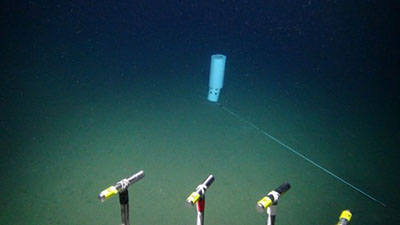
Rachel Pugh
Graduate Research Assistant (M.S. Program)
School of Ocean Science and Engineering, University of Southern Mississippi
Dr. Justyna Hampel
Post Doctoral Research Associate
School of Ocean Science and Engineering, University of Southern Mississippi
While you may not be able to see them, microbes are abundant and present in all habitats on Earth—including the deep sea. Microbes are an essential component of every ecosystem, and this certainly holds true for the seafloor. The deep seafloor is hardly a flat expanse or barren desert; it is rich with natural habitats and built structures. Natural habitats include cold seeps, hydrothermal vents, and seamounts. Built structures on the seafloor include oil rigs and artificial reefs. Despite the lack of light, cold temperatures, and high pressure, microbes thrive in these environments. Deep-sea sediments are among the most diverse ecosystems on the planet, with up to 10,000x times more microbes than ocean waters. However, due to limited access, the deep seafloor remains a frontier for discovery of habitats and their associated microbes.
Built environments are human-made features and structures, and in the ocean include oil rigs, artificial reefs, and shipwrecks. These environments can provide a habitat and structural basis for microbes to attach and colonize. The collective microbial composition at a certain place is known as a microbiome. Once the microbiome is established in a biofilm on the built structure, larger organisms, including corals, crabs, and bivalves, are drawn to these structures for food and refuge. The structure becomes a focal point of biodiversity thanks to the foundation provided by the microbiome.
Shipwrecks have often been overlooked in the study of environments on the seafloor. We are beginning to recognize them as habitable environments and investigating if they have any influence on the biodiversity and biogeography of seafloor microbes.
Biogeography is the non-random distribution of organisms across space and time. In deep-sea ecosystems, microorganisms represent the majority of lifeforms; knowing where they are, how they got there, what factors impact them, and how they influence the surrounding environment is important to understanding marine ecology in general, and fundamental to studying marine microbial ecology.
The Gulf of Mexico has more than 2,000 known historic shipwrecks. It is likely that these built structures shape the environment and microbial life on the seafloor, and that microbes are transported between them. Since historic shipwrecks are somewhat isolated from another, each shipwreck could be considered as an island. We are testing the hypothesis that shipwrecks are indeed islands, and therefore, microbial life exhibits island biogeography. This means that each island has a signature microbiome that is not found between islands, and that the microbial diversity will be highest near the shipwrecks, and decrease away from them.

Biofilm recruitment experiments, like the one pictured here, will include wood samples to study how microorganisms are ‘island hopping’ across built wood structures on the seafloor. Image courtesy of Hamdan Lab, image collected by the Odysseus ROV in September 2018. Download larger version (jpg, 71 KB).
If shipwrecks are an island and serve as diversity “hotspots,” we can devise tools that use these signature microbiomes to help discover new shipwrecks solely by looking for microbial communities on the seafloor. Our work will establish experiments on the seafloor that allow us to catch the microbes transported between structures and monitor how they move across the seafloor. Knowing how microbes colonize structures and move across the seafloor and between islands, and how shipwrecks influence microbial communities will enhance knowledge of the deep sea.

Acoustic landers used to recover biofilm recruitment experiments on the R/V Point Sur after spending four months on the Gulf of Mexico seafloor. Image courtesy of Microbial Stowaways. Download larger version (jpg, 1.5 MB).